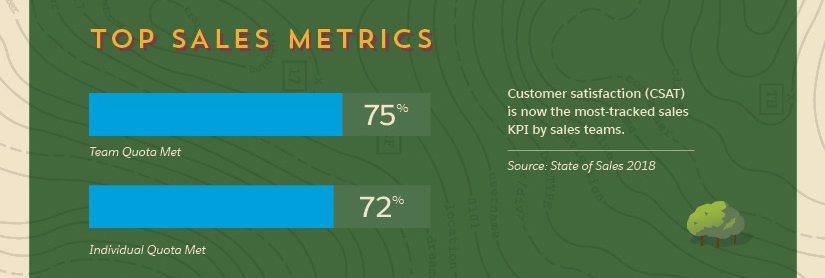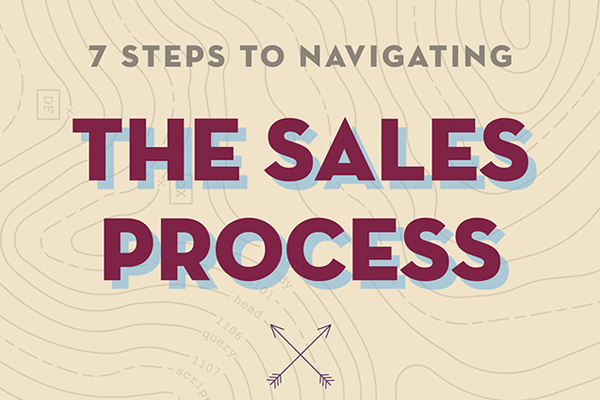The sales process from prospect to close is often full of uphill climbs, twisting paths, and unexpected turns. Salesforce sales teams navigate these obstacles daily, which is why we asked them what steps they take to turn their prospects into brand advocates. We turned these tips into an infographic, e-book and blog series to help sales teams do the same.
Over the next several weeks on the blog we’ll charter a path through the entire sales process, using insights from our sales teams as the compass. We’ll dig into how to identify customer pain points, demonstrate the value of your business in a pitch, tactfully negotiate the contract, and much more.
Your journey through the sales process starts here.
The sales process from prospect to close is often full of uphill climbs, twisting paths, and unexpected turns. Salesforce sales teams navigate these obstacles daily, which is why we asked them what steps they take to turn their prospects into brand advocates. We turned these tips into an infographic, e-book and blog series to help sales teams do the same.
Over the next several weeks on the blog we’ll charter a path through the entire sales process, using insights from our sales teams as the compass. We’ll dig into how to identify customer pain points, demonstrate the value of your business in a pitch, tactfully negotiate the contract, and much more.
Your journey through the sales process starts here.
The sales process from prospect to close is often full of uphill climbs, twisting paths, and unexpected turns. Salesforce sales teams navigate these obstacles daily, which is why we asked them what steps they take to turn their prospects into brand advocates. We turned these tips into an infographic, e-book and blog series to help sales teams do the same.
Over the next several weeks on the blog we’ll charter a path through the entire sales process, using insights from our sales teams as the compass. We’ll dig into how to identify customer pain points, demonstrate the value of your business in a pitch, tactfully negotiate the contract, and much more.
Your journey through the sales process starts here.
Stage 1: Contact Leads
TOP TIP: Build Trust at the Start
78% of business buyers in the UK seek salespeople who act as trusted advisors. Before you start your sales journey, prepare to walk a mile in your prospect’s shoes. Do your research—make sure you understand your prospects pain points, their business model, and the future challenges they may face.

Add value where you can by educating your prospect —they may know nothing about your business or the landscape you work in. Show them where there is a gap that you can fill. This is the foundation that you can use to build your vision and show how you can work together.
In this e-book chapter we also address:
How to start the conversation — ask questions, build on previous experiences
How to use inbound marketing to control your costs and target the right prospects
How to leverage your network and build partnerships to strengthen your offering
Build on previous success through referrals from customer advocates
Stage 2: Qualify Leads
TOP TIP: Let Leads Do the Talking
78% of salespeople said that listening had a substantial impact on converting a prospect into a customer. Before diving straight into who you are and what you do, ask them if they’d like to tell you what they need, what’s important to them, and what they want to get from the conversation. It sets a powerful precedent.

Download the e-book to learn more in this chapter about how to:
Qualify leads with a customer-centric approach
Listen and learn as much about them as you can
Utilise the skills of your team to qualify and evaluate a lead
Stage 3: Provide Value
TOP TIP: Validate the Benefits & Value You Have to Offer
It’s been a bit of a trek, but at last you’ve made it to the pitch. Rather than give you tips about building a deck and power posing, we’re keeping it simple: show them in your presentation *specifically* how you and your company can add value and work together to achieve their goals.

This means utilising the power of your team. Dig into the data, pull out successful content like case studies or testimonials, and show them not only that you can fit into their vision, but that they fit into yours.
Download the e-book to learn more in this chapter about how to:
Focus on their needs and problems they want to solve.
Speak the same language as your prospect
Build on the education you’ve already provided
Give them a glimpse of the end goal
Stage 4: Handle Objections
TOP TIP: Keep the Conversation Going
Top sales performers counter client objections over 23% more often than average performers. Objections are opportunities to learn more about your prospect’s needs. Let them fully explain their objections and ask lots of follow-up questions so you can understand the root of the issue.

Objections are not punishments – they’re information. They represent another opportunity for you to offer your leads value and solutions to their problems. You don’t want anyone to climb a mountain with you if they aren’t ready for it.
Download the e-book to learn more in this chapter about how to:
Identify the opportunity behind different types of objections
Handle last-minute objections during and after a pitch
Follow up after the dust has settled
Stage 5: Structure the Deal
TOP TIP: Use your Tools to Build a Proposal that Works for Both Parties
The stage before you get a “yes” can be the most tricky. It’s also sometimes hard to stay objective when you’re crunching the numbers and crafting the proposal. Structuring a deal that makes everyone involved happy means keeping your future customer in mind while still holding your ground. That could be why configure price quote software is projected to grow 126% over the next two years.

By now, you should know this customer has the “Budget, Authority, Needs, and Timeline” (BANT) needed to move ahead with your deal. Part of proving your price point is legitimate is doing your homework and being able to show your work — utilise your tools and your team to calculate a fair deal. For example, don’t include extras that could be a nice upsell, but could interfere with client success.
Download the e-book to learn more in this chapter about how to:
Focus the discussion on value, not just cost
Know your limits and know how much to give in a negotiation
Show that you still have their interests in mind
Trade rather than give away services
Ensure everyone is ready to move forward with the deal
Stage 6: Finalise the Proposal
TOP TIP: Utilise all the Information You’ve Gathered Along the Way
It’s normal for negative buyer sentiment to increase as you get closer to the end of negotiations. That’s why it’s important to lean on the rapport and research you’ve done along the way.

A customer relationship management system (CRM) is extremely handy in these situations- it can help you review past conversations, promises, and pain points discussed at the beginning.
Download the e-book to learn more in this chapter about how to:
Utilise your tools to reinforce your value and what you have to offer
Navigate the internal world of your potential customer’s business
Hold your ground or walk away if you come to an impasse
Stage 7: Close and Keep Commitments
TOP TIP: A Great Hand-off is Key to Long-Term Success
Customer satisfaction is now the most-tracked KPI by sales teams worldwide. For good reason—the bottom line of a company rests on repeat and ongoing business deals. You’ve worked so hard to get this customer across the line, make sure all that time and resource doesn’t go to waste.

Once you close the deal and the ink has dried, make sure you set your new customer up for success. This comes down to the hand-off you provide to the new point of contact—whether that’s a client relationship person like an account director or a customer service team. Send along all your notes, your vision, and customer history to make sure nothing falls between the cracks.
Download the e-book to learn more in this chapter about how to:
Ensure your promises are kept long after you clost
Hand off a customer to a teammate
Utilise your technology to ensure you follow thought
Meet their needs as a new customer
Tips from the Summit
This insight on the sales process comes straight from Salesforce’s trail-blazing sales teams and thought leaders. We have created game-changing sales, marketing, and CRM solutions with an emphasis on innovation and a customer-centric approach, which means we’ve got quite a bit of insight to pass on.
Our aim is to provide trailblazers the map and technology they need to build successful customer relationships and reach the summit with their new customers. See you on the trail!









